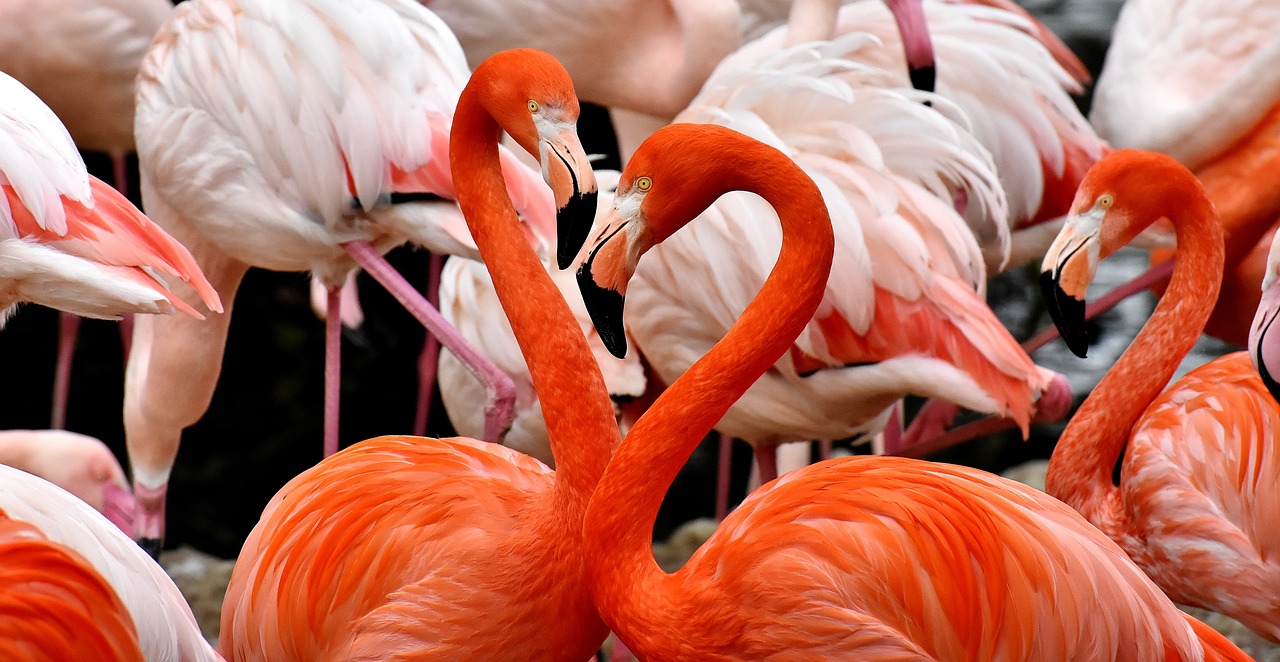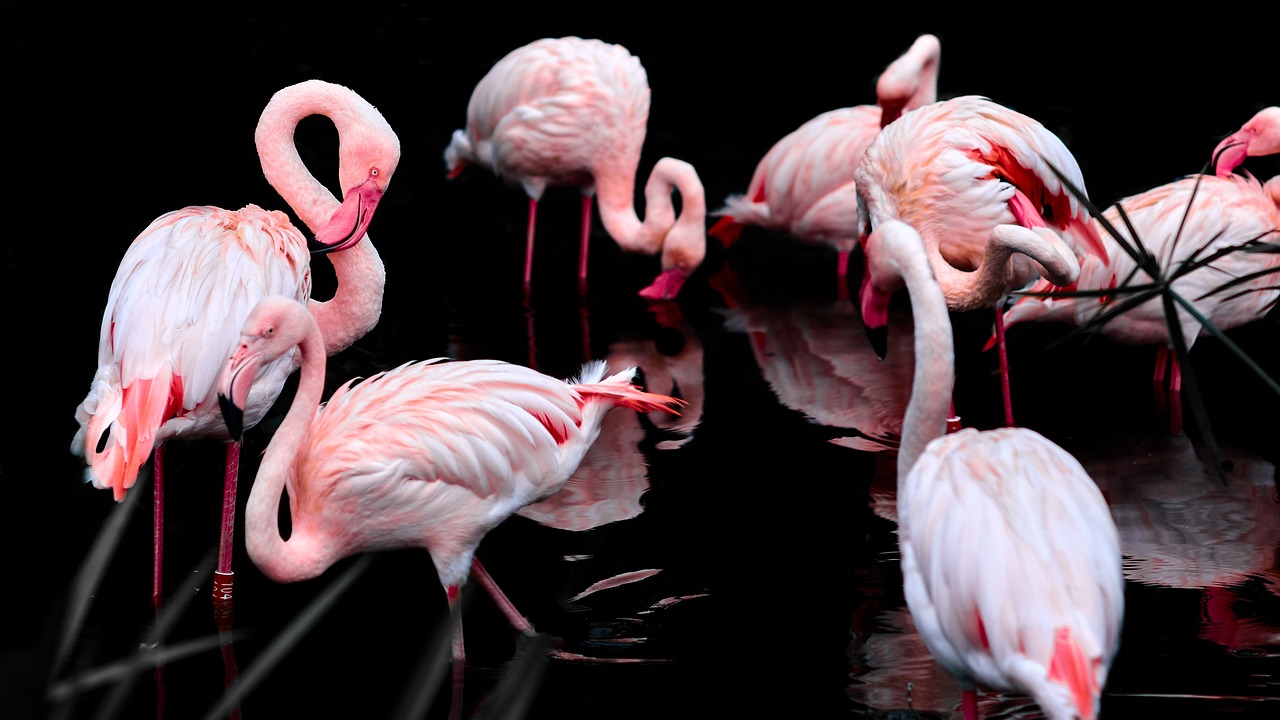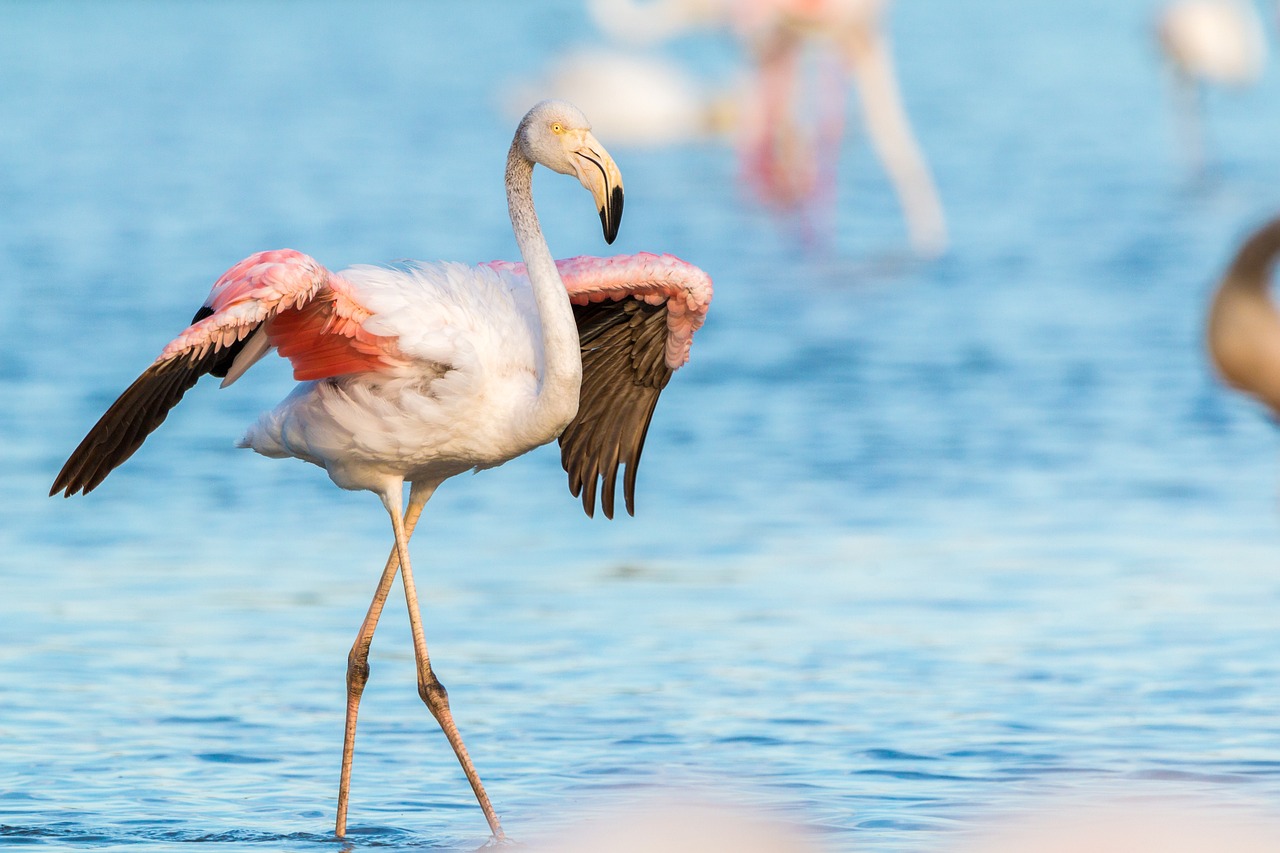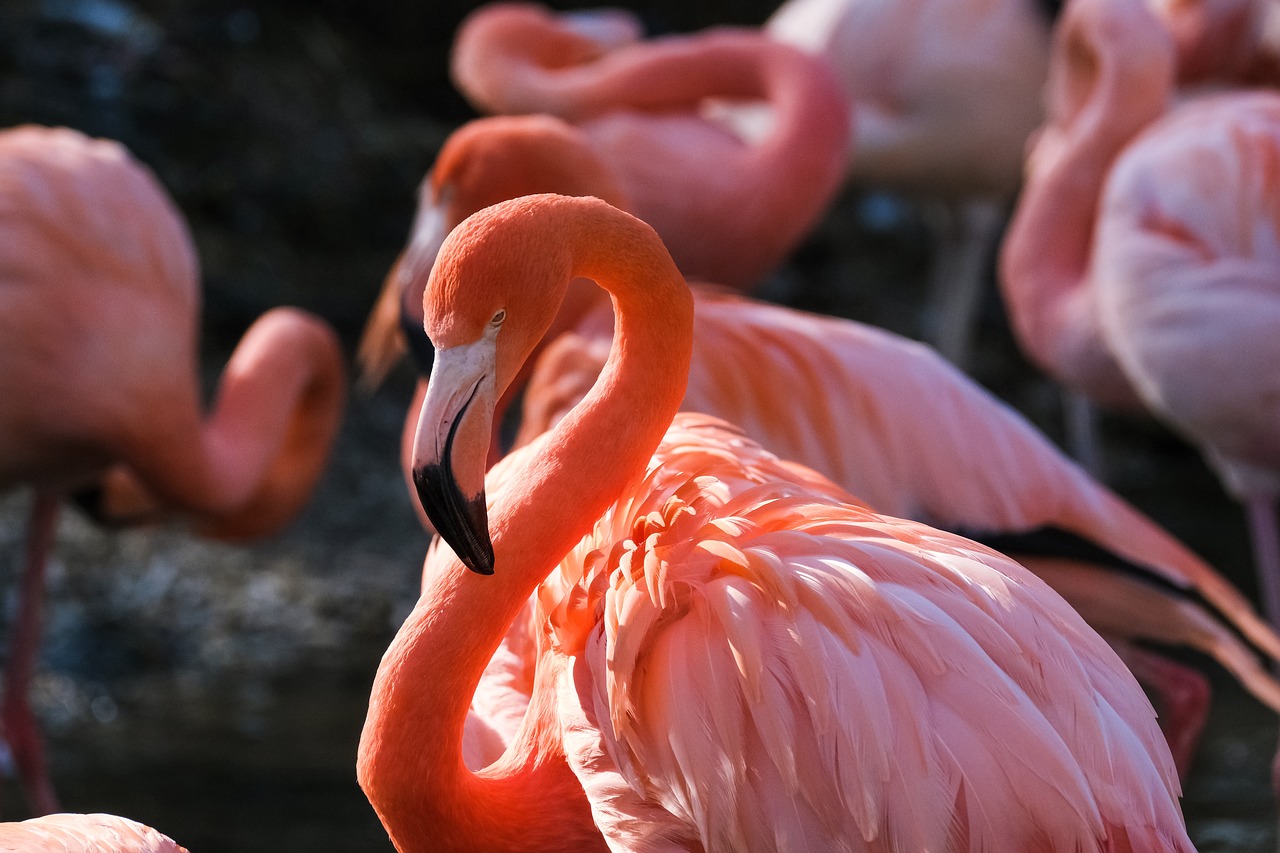Table of Contents
intro
Flamingos have an incredibly unique appearance. With their long legs and elegant necks, it’s no wonder why they are some of the world’s most recognizable birds. But what is the origin of their unmistakable pink hue? Why are flamingos pink? This article seeks to explore the reasons why flamingos display this particular coloration, examining their diet and environment to help explain the mystery.

What are Flamingos?
Flamingos are large, wading birds known for their vibrant pink feathers and long, slender legs. These birds are native to South America, Africa, Asia and the Caribbean islands. They live in shallow lakes or lagoons that have high saline content because these habitats provide them with a plentiful supply of brine shrimp – one of their favorite foods.
Flamingos are social animals and prefer to live in large colonies that can contain tens of thousands of individuals. When they gather together, their plumage creates a stunning visual spectacle as the bright pink color reflects off the water below. But why are flamingos pink? The answer lies in their diet which is rich in carotenoid pigments found in algae and crustaceans like shrimp. These pigments get deposited into the feathers over time, resulting in the characteristic pink hue we all know and love.
Interestingly enough, not all flamingos have pink feathers throughout their lifetime. Younger birds start out with grayish or white plumage which gradually changes as they begin to eat more carotenoids from their surroundings. The intensity of coloring also varies depending on where the flamingo lives and what it eats – some populations may appear much paler than others due to differences in food availability or other environmental factors such as pollution levels or climate change impacts on habitat quality.

Physical Anatomy
Flamingos are known for their beautiful pink hue, but have you ever wondered why they are that color? It turns out that the reason has to do with their physical anatomy. Flamingos feed on small crustaceans and algae that contain carotenoids, which are pigments found in plants. These pigments give off a red or orange hue, and when flamingos consume them in large amounts, it gets deposited into their feathers.
The pink color of flamingos is not only limited to their feathers. Their legs also share the same pigment due to a similar process of deposition from the food they eat. It's important to note that not all flamingos are born with this pink coloration; it develops over time as they consume more carotenoid-rich foods.
In addition to contributing to their unique appearance, the presence of carotenoids in flamingo diets may also provide health benefits by acting as antioxidants and boosting immune function. Overall, the physical anatomy of these fascinating birds plays an important role in both their appearance and well-being.

Diet
While the topic of flamingos and their pink color may seem unrelated to diet, it actually plays a significant role. Flamingos get their distinctive pink hue from the pigments found in the algae and crustaceans they consume. Specifically, these creatures contain high levels of carotenoids, which are responsible for giving flamingos their bright pink color.
Interestingly, flamingos aren’t naturally pink. When they’re born, they’re actually gray or white, but as they begin to feed on these pigmented creatures in their environment, their feathers gradually turn pink over time. In fact, flamingos that live in areas with little access to these pigmented foods tend to have paler feathers than those living in areas where these foods are abundant.
Overall, this is a fascinating example of how an animal’s diet can play such an important role in its appearance and overall health. It also highlights the importance of eating a varied diet rich in nutrients like carotenoids that can provide numerous benefits for humans as well.

Temperature & Sunlight
Flamingos are known for their vibrant pink color, which is a result of two main factors: temperature and sunlight. The pigments that give flamingos their distinctive coloration are called carotenoids, which are found in the algae, crustaceans and plankton that flamingos eat.
When flamingos consume food rich in carotenoids, the pigments are absorbed into their bloodstream and stored in their feathers. However, these pigments aren't always visible until they're activated by specific conditions. The first condition is temperature: when flamingos get warm, they increase blood flow to their skin surface which exposes more of the bright pink feathers underneath.
The second factor is sunlight. When sunlight interacts with the carotenoid pigments in flamingo feathers, it causes them to appear brighter and more vivid. This explains why captive flamingos often lose some of their pinkness – without exposure to intense sunlight or warm temperatures, the pigments won't activate as readily. Overall, while diet plays a key role in influencing flamingo coloration through its provision of carotenoids; environmental factors such as temperature and sunlight also play a crucial role in giving these birds their iconic appearance.

Color Adaptation
Flamingos are one of the most fascinating creatures in the animal kingdom. They are known for their signature pink color, which is a result of their unique diet and color adaptation process. Flamingos have a filter-feeding mechanism that allows them to consume large amounts of microscopic algae, brine shrimp, and other aquatic organisms that contain pigments called carotenoids. These pigments are responsible for giving flamingos their distinctive pink hue.
The carotenoids in the flamingo's diet are broken down into smaller compounds called astaxanthin and canthaxanthin, which get stored in the bird's feathers and skin. As the flamingo grows older, it accumulates more of these pigments, resulting in a brighter shade of pink. In addition to helping with coloration, these pigments also act as antioxidants that protect against cell damage caused by free radicals.
Interestingly enough, not all flamingos have the same shade of pink due to varying levels of pigment accumulation from different diets or environmental factors such as water salinity levels or exposure to sunlight. However, regardless of their shade variation, flamingos remain one of nature's most stunning examples of color adaptation.

What Are The Different Species Of Flamingos
There are six different species of flamingos, each varying in size, color, and habitat. The most iconic is the Greater Flamingo, which can be found in many zoos worldwide. Chilean Flamingos reside in the salt lakes of South America, while the Andean and James's Flamingos can be found in high-elevation wetlands, such as the Andes. The Lesser Flamingo, on the other hand, prefers to live in shallow, alkaline, salt lakes.
As soon as flamingo chicks are born they consume crop milk, which their parents produce in their esophagus, until they are old enough to eat blue-green algae, the main source of fat in their diet. Understanding the different flamingo species and their unique characteristics is important for conservation efforts and to appreciate the diversity and beauty of these magnificent birds.

What Is A Group Of Flamingos Called
Flamingos are known for their vibrant pink color, but have you ever wondered why they a A group of flamingos is called a flamboyance, and it's the perfect name for these striking birds. Flamboyance is derived from the French word “flamboyer,” which means to flame or blaze. And that's exactly what a group of flamingos does – they create a dazzling display of color and movement that's hard to miss.
These social birds live in large flocks, often consisting of hundreds or even thousands of individuals. They communicate with each other through various vocalizations and body language, and they're known for engaging in courtship rituals that involve synchronized dancing and preening. Whether they're standing still in shallow water, taking off in a massive flock, or flying overhead in a graceful V-formation, a flamboyance of flamingos is truly a sight to behold.

Migration Patterns
Flamingos are known for their vibrant pink color, but have you ever wondered why they appear this way? The answer lies in their diet. Flamingos feed on algae and crustaceans that contain pigments called carotenoids. These carotenoids are broken down into a compound called astaxanthin, which gives the flamingos' feathers and skin their distinctive pink hue.
Interestingly, the amount of carotenoids in a flamingo's diet can affect the intensity of its coloration. Flamingos that consume more carotenoids will have brighter pink feathers than those that consume less. In addition to being a striking visual feature, the pink coloration also serves as a form of social signaling among flamingos.
In conclusion, while many may find it strange that birds can be so brightly colored due to their diets, it is a natural occurrence seen in many species such as flamingos who depend on certain food sources for their unique appearance.

Conclusion: Why Are Flamingos Pink?
In conclusion, flamingos are pink due to their diet. These birds consume algae and crustaceans that contain carotenoids, which are natural pigments that give them their distinctive color. The more carotenoids they consume, the brighter and more vibrant their pink feathers become.
However, it's worth noting that not all flamingos are pink. Some species have white or gray plumage. This is because the amount of carotenoids in their diet may vary depending on factors such as location and time of year.
Despite this variability, the striking pink hue of flamingos has captured the attention and fascination of people around the world for centuries. It is a testament to both the unique biology of these birds and the beauty and wonder of nature itself.a

Related Articles
Britannica Why are flamingos pink?
https://www.britannica.com/story/why-are-flamingos-pink
National Zoo Why are flamingos pink and other flamingo facts.
https://nationalzoo.si.edu/animals/news/why-are-flamingos-pink-and-other-flamingo-facts
New Scientist Why are flamingos pink?
https://www.newscientist.com/question/why-are-flamingos-pink/
Science Focus Why are flamingos pink?
https://www.sciencefocus.com/nature/why-are-flamingos-pink/
Parade Pets Why are flamingos pink?
https://paradepets.com/pet-news/why-are-flamingos-pink
The Sun Why are flamingos pink?
https://www.thesun.co.uk/news/13711754/flamingos-pink/
Wonderpolis Why are flamingos pink?
https://wonderopolis.org/wonder/Why-Are-Flamingos-Pink
BBC Why are flamingos pink?
https://www.bbc.co.uk/newsround/40964645
Kids TPL Why are flamingos pink?
https://kids.tpl.ca/wonders/797
Murray Edwards School winner Why are flamingos pink?
American Shrimp Why are flamingos pink and what does it have to do with shrimp?
https://americanshrimp.com/why-are-flamingos-pink-and-what-does-it-have-to-do-with-shrimp/
Academy Lesson Why are flamingos pink?
https://study.com/academy/lesson/why-are-flamingos-pink.html
Nerd Momma Why is the sky blue?
https://nerdmomma.com/why-is-the-sky-blue-7-fascinating-facts/#more-1667
